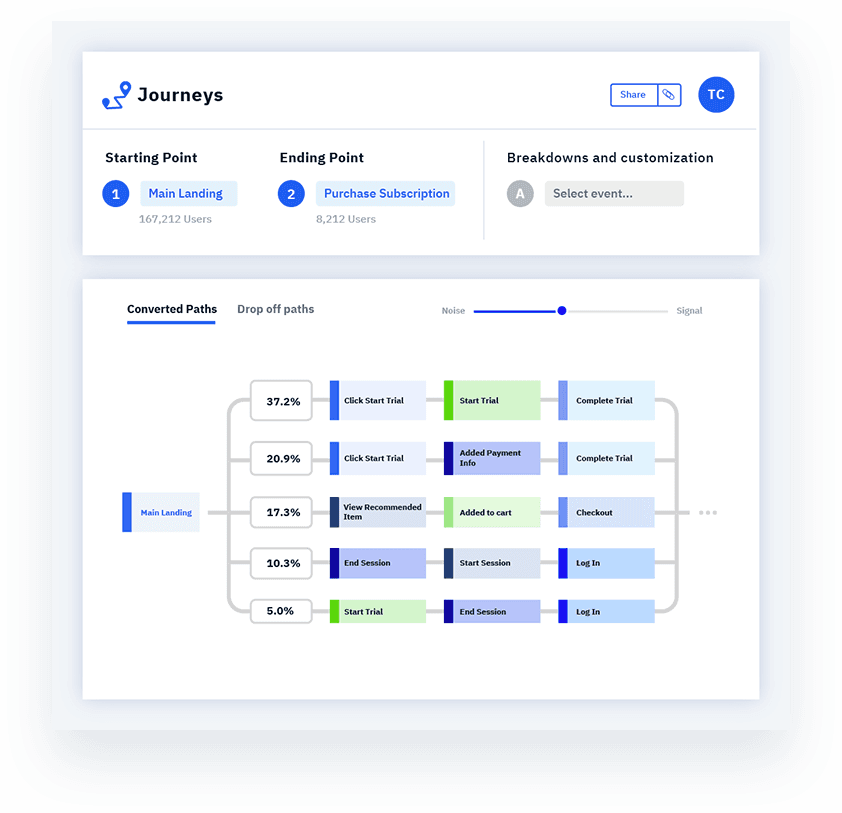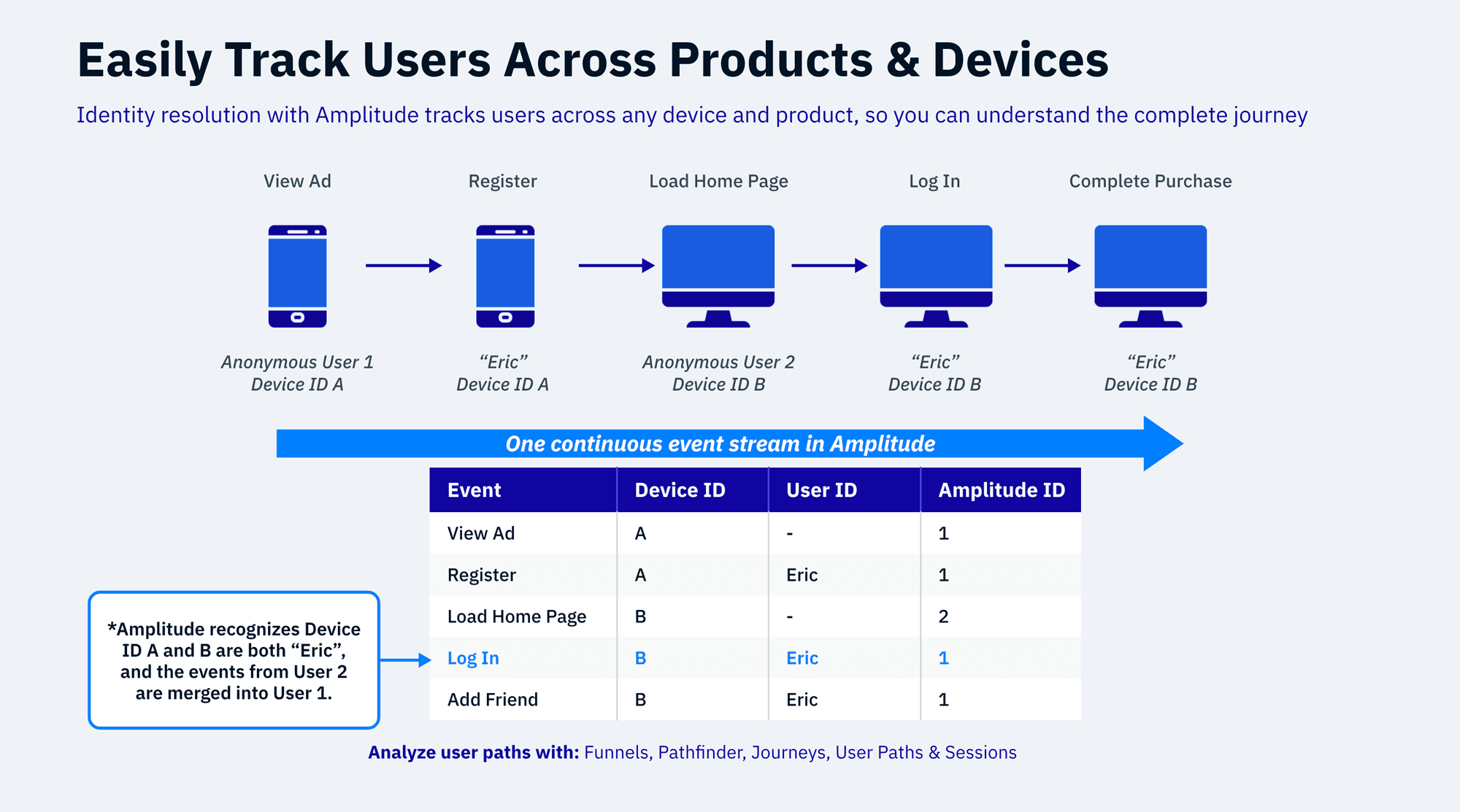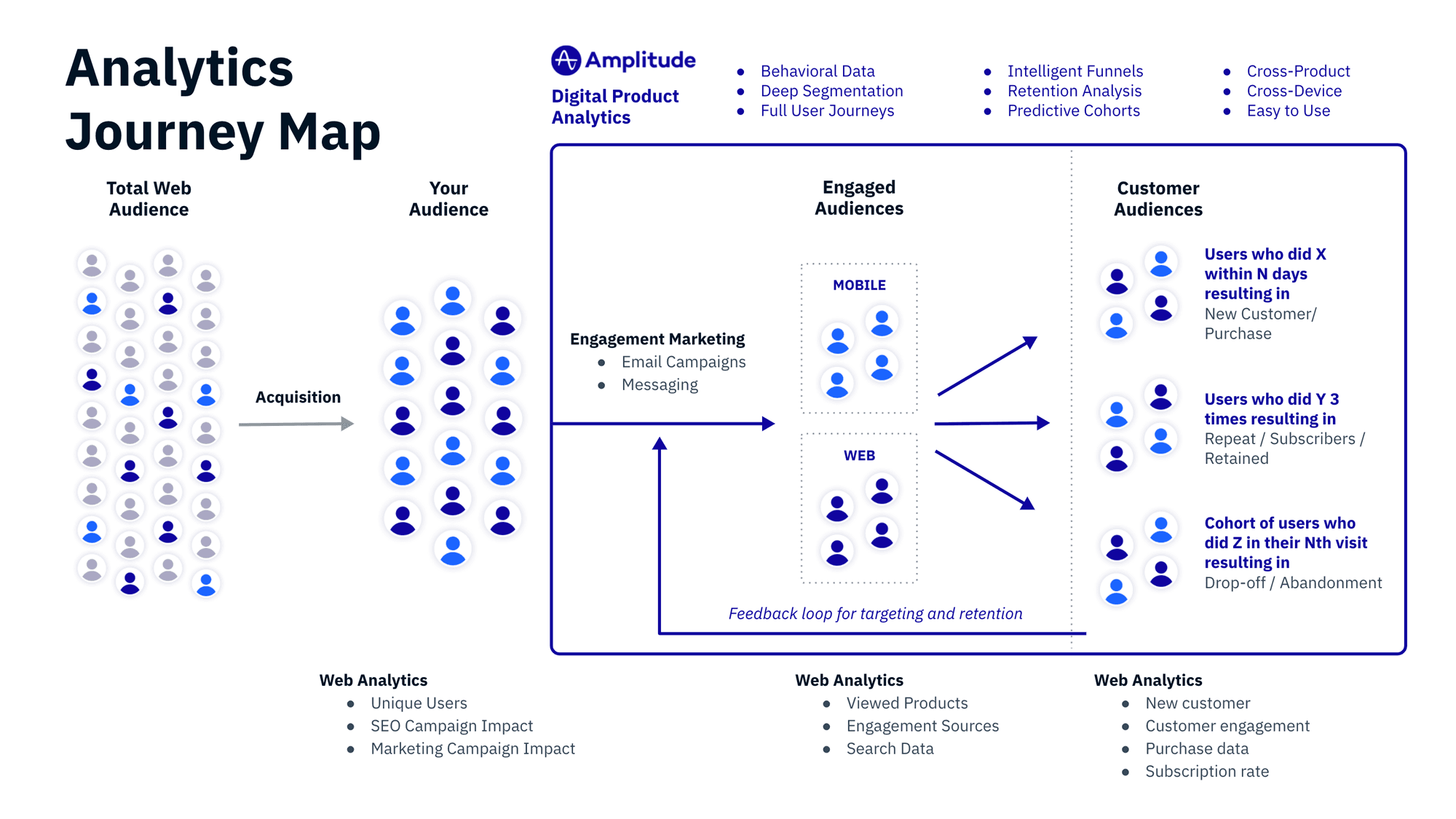5 Use Cases that Show Why Marketers Love Amplitude
As MarTech experts, the team at McGaw.io get asked about analytics all the time. Here’s why we recommend Amplitude for marketers.
It’s time we think a little differently about analytics.
Websites have evolved from promotional outlets to product experiences, but many marketers still use analytics tools that don’t suit the new reality. There’s a need to understand the story of how users navigate the complex landscape of multiple touch points and platforms.
This is the issue Amplitude solves with excellence — bridging product- and marketing-based insights with a deeper analysis of the full customer journey.
In our practice as a MarTech agency with a variety of clients and custom implementations, we’re frequently asked about our choice in user analytics platforms. Today, I’ll explain why we favor Amplitude.
Amplitude’s Approach to Marketing Analytics
Amplitude’s approach to event-based analytics and data originated from the struggles of the early commercial web, where marketing analytics mostly measured clicks, identified traffic sources, and tracked a few conversion rates.
Amplitude imagines the function of analytics differently. By tying metrics to event-based triggers, integrating more first-party data sources, and making data exploration easy, marketers can ask and answer much bigger questions about user behavior like retention, lifetime customer value, and long-term ROI. You’ll appreciate that when designing marketing strategies or creating tech solutions.
Instead of having a fixed dashboard or really having to plan reports [in advance], you just have to drill down to a user, and see the promotion they viewed to get to the site. It makes it possible for marketers to dig in, swim around in the data, and continue to explore and peel the onion, to understand what’s driving their business.
This transforms marketing analytics from a reporting function to the heart of a platform built for understanding and improving the customer experience, so you can use the insight to increase revenue.
A Completed User Journey
Maybe the biggest problem with traditional web analytics is their limited coverage of the complete customer lifecycle.
Sure, cost per click and conversion rates are vital metrics. Still, they say little about the customer experience and nothing about a wide range of activities outside designated marketing checkpoints.
How does Amplitude expand the user journey? By joining product (and app) activity with web behavior and leveraging ID resolution to follow end-users through more interactions.
Tying Product and App Activity with Web Metrics
In their customer lifecycle, users will bounce between marketing materials and product interactions. Understanding how both experiences support and negate each other is essential if you’re looking to make improvements to your marketing.

Amplitude’s checkout conversion paths show the most common ways visitors become ecommerce customers—or reach another defined goal.
Tying together app and marketing data means more meaningful metrics like lifetime value and churn, which give you a longer view of your product lifecycle. It also lets you ask much bigger questions about your users’ behavior and value to your bottom line.
What kind of questions?
- How does customer loyalty differ between marketing channels?
- Which sources drive the most unique views?
- Which conversion step experiences the greatest dropoff?
- How does the responsiveness of our product impact retention rates?
- What’s the relationship between the usage of various features and churn?
Seamless Tracking of the User Journey
Cookie-based tracking has a knowledge problem. Its data can’t explain customer dynamics well.
What does that mean?
Let’s say your analytics solution shows paid search as the highest converting channel. The natural next step would be to double down, right?
Not exactly. You could have missed a crucial detail by not evaluating channels with integrated analytics like churn and lifetime value. Maybe that traffic churns at a higher rate or lacks the loyalty of customers from organic traffic.
With this integrated infrastructure, Amplitude can track individual users long before filling in a form, and long after their first purchase. This creates an uninterrupted data stream, offering another layer of data into the customer journey.

Amplitude’s identity tracking collects disparate user identities into one whole, regardless of the device used.
Additionally, this enhanced, CRM-like database can be easily imported and exported to the tool of your choice. It’s been a life-saver.
We’ve even used this as a backup CRM whenever anything fails. We’ve had situations where a client’s automation system stopped capturing leads because of an error. We were able to go into Amplitude and actually export all the leads really quickly.
Reporting Speed and Ease of Use
Data is a prerequisite to sound decision-making.
The quicker you can identify insights, the faster you will act on them. Beyond integrating disparate data sources, Amplitude’s speed and ease of use helps organizations accelerate their feedback loops. The time it would take to build a checkout report without Amplitude, for example, would be extensive.
Amplitude’s ease of use doesn’t come at the cost of dumbing down the analytics. It’s about quickly enabling your team to explore data without the resource-intensive back-and-forth with BI staff.
It’s hard to overstate just how much of a difference this clear interface makes. Regardless of where users fall on the org chart or their technical literacy, they can easily self-serve what would otherwise require specialized help.
Teams can quickly group users and compare how various marketing efforts impact conversion, identify funnel drop-offs, and uncover retention drivers.
All it takes is a few clicks.
Amplitude Features: Checkout Funnels, A/B Testing & Seamless Integrations
Amplitude’s breadth of reporting and accessibility helps enormously, but its many supporting features and integrations can deepen the marketing insights even further.
Seamless Integrations with Leading MarTech Tools
Numerous out-of-the-box integrations help us use Amplitude across our clients’ diverse range of business models and industries.
Amplitude’s partner directory lists several pages of official partners. You’ll also find Amplitude recommended on integration lists of other quality tools, such as Segment or Braze.
In my experience, Amplitude reliably integrates with most major MarTech for any business function or vertical. That includes Salesforce, AWS, Snowflake, Zendesk, Slack, or Intercom. These integrations add powerful functionality. When you, for instance, integrate with user messaging platforms like Braze, you can achieve personalized messaging triggered by user activity or traits.

Or, connect to your app location manager via API and give your users automated location-based enticements.
Flexible Visualizations of Checkout Funnels for Custom Analysis of User Paths
Amplitude’s checkout funnel reporting does much more than track the flow of users along your conversion path. By letting you easily tailor your visualizations, you can drill down and analyze every step in-between.
This is a favorite feature in our team (the second being Amplitude’s A/B testing).
Anytime we need to track a series of steps, a funnel, a lead generation process, Amplitude is really phenomenal at that. This is one such funnel analysis we ran for one client:

Above you see the steps we decided on for our checkout funnel, beginning with users adding a product and closing with applying their payment method.

Without that information, you’d have to guess. Maybe users are confused about the next step; maybe you’ve overloaded them with information.
Clear and well-designed visualizations convey an enormous depth of data. By carrying more of the user’s cognitive load, you can process and validate findings much easier.
More than that, Amplitude also helps you uncover why some users convert when they do and why others don’t. Compare user activity and traits activity across various user groups, and you’ll have all the tools you need to fix problem areas or grow what already works.
A/B Testing for Analyzing the Performance of Your Tests & Campaigns
Amplitude’s A/B testing tool makes running experiments as easy as running a report.
You can quickly run A/B tests with Amplitude Experiment and compare any slice of their audience to a control group or alternate versions of the same campaign. The latter makes it easy to compare campaigns.
Combined with Amplitude’s funnel analysis, marketers can quickly gather whether a test is statistically significant, or see how campaigns may impact funnel conversion rates or retention.

Above you see a user tracking the customers who add a product to their cart and then complete the transaction. With Amplitude you can create an experimental group of customers who see a page that contains a menu of five blog posts—compared to a control group where nothing changes.
Even if you aren’t using Amplitude Experiment, and are using a tool like VWO, Optimizely, or Google Optimize, you can still use Amplitude’s funnels to understand your test results. And, unlike other testing analytics, you can drill down and explore relationships between your test and other outcomes that weren’t planned for. Did you bring in new customers with a discounted first-year promotion, but then they didn’t renew afterwards? You couldn’t find that information easily in Google Analytics, but Amplitude makes it a snap to do this sort of long term historical analysis and extend your funnels over time.
Amplitude Lets You Answer your Most Burning Customer Questions
Amplitude is an easy recommendation. It makes data exploration fluid and accessible. It fits like a glove into our client’s tech stacks, and opens up a lot of impressive functionality through its many integrations.
If you’d like to explore more of Amplitude’s marketing capabilities, drop us a note anytime. Here at McGaw, we specialize in marketing automation, marketing analytics, funnel optimization and product growth. We’re experts in the MarTech stack, and invested in finding the right solution for your needs,

Nik Friedman TeBockhorst
Vice President of Solutions, McGaw.io
Nik is Vice President of Solutions at McGaw.io. He has more than 20 years of experience as an integrated marketing strategist, specializing in growth marketing, marketing automation, marketing ops, conversion rate optimization (CRO), analytics, and business strategy.
More from Nik




